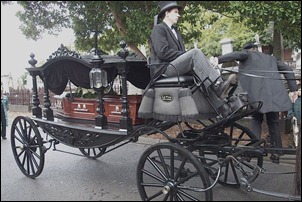 Monique wrote to me about a funeral she recently went to in France and about French Funeral traditions in general. Here’s her letter:
Monique wrote to me about a funeral she recently went to in France and about French Funeral traditions in general. Here’s her letter:
It was awfully hot on the day of the funeral so it was decided that we would drive to the churchyard. If the burial had been in the morning or if the weather had been mild, we’d have walked behind the hearse up to the churchyard.
Btw, they called the street that goes up to the churchyard "Chemin de l’Égalité" (Path of Equality) because we’re all equal in the eye of death.
I asked Monique if it’s common in France to follow the hearse on foot. In the US, we generally drive behind the hearse to the graveyard. The cars in the procession all have their headlights on so other drivers know to let the procession pass. Here’s how Monique answered my question:
Following the hearse on foot: in small towns, yes, it’s typical. When I was a child, the hearse was an "actual" horse-drawn hearse and people would walk behind it. People still follow the hearse on foot in small towns because the graveyard isn’t far from the church if there’s a religious service, or even if they go from someone’s house if it’s somewhat on the outskirts of the town.
If you check with Google maps, you’ll see that our graveyards are quite close (within a mile). Btw I was looking at the towns around my father’s birth town and found another graveyard street called "rue de l’égalité" so I suppose there are many streets with that name.
Besides, in small towns, everybody knows everybody. I wouldn’t say it’s more fun to go on foot but this is the idea anyway though it’s not about fun it’s about being still alive and enjoying the fact in a certain way; the living accompany the dead and unless it’s a child or a young person in which case it’s felt as unfair and unjust, and then everybody grieves. When it’s an older person they talk of him/her but also they give one another news about family members, etc. Besides, it gives a feeling of togetherness that makes everybody feel better, even the people who grieve most. We humans are social animals, we need to feel we belong to a "tribe", that we’re not alone and the "tribe" -whatever the "tribe" may be – is here for us for help and support.
Since we drove to the funeral we went to, at the graveyard we met other people who had gone directly from their homes too. It’s the same "ritual" at each funeral: "Who are you?" "I’m So and So’s son/daughter" "I wouldn’t have recognized you" and "It’s been so long! How are you doing? And how are your children? Do you have any grandchildren yet?" and "Is that your grandson? Oh my!" and whispering "Who’s that?" "So and So" and "Who was the man like this and that…?"
Later, Monique wrote more about funeral traditions in France:
In small towns, the family of the deceased places a book and pen on a small table that’s covered with a black cloth by their front door. When people pass by, they write their condolences in the book. In bigger towns and in cities, the books are at the funeral homes.
When the deceased is laid out at the home, the people who knew him/her go "visit", i.e. go to see the dead and present their condolences to the family. In bigger towns and in cities, the deceased is laid out in a funeral home, so you go there to see the dead and write your condolences in the book.
At the end of the ceremony or when people are at the graveyard, the family members thank the people who came to attend the funeral. They stand in a row and shake hands with them. Sometimes, when the deceased was a young person or someone who died suddenly and the family members are too disconsolate, the priest, or the person who runs the ceremony if it’s not religious, says, "there will be no hand shaking".
Often, the closest family members of the deceased prepare drinks and food at the home. After the funeral, relatives and close friends are invited to have a drink and a small bite. It’s a way for the those in mourning not to be left alone at the end of the funeral. It also helps everybody to unwind after the surge of emotions the funeral causes.
In yesteryears, when people would travel slowly, the family would cook a big meal so that everybody who came wouldn’t go back home with an empty stomach. I don’t know if this is still done in some areas, I never saw it done myself.
Thanks Monique for sharing these traditions with us.
The tradition of people following horse drawn hearses on foot to the graveyard was not unique to France. They also followed this custom in England and sometimes in the U.S.
It’s interesting to learn about funeral traditions in different cultures. I think it’s important to be able to speak with children about this type of subject. When it’s talked about, perhaps it’s made a little less scary.
-Mama Lisa
Monique works with me on the French version of Mama Lisa’s World.
This article was posted on Friday, August 10th, 2012 at 5:45 pm and is filed under Countries & Cultures, Customs and Traditions, France, French, Funeral Traditions, Languages, USA. You can follow any responses to this entry through the RSS 2.0 feed. You can skip to the end and leave a response. Pinging is currently not allowed.

























December 10th, 2014 at 9:59 pm
Nice article. The mother of A dear French friend of mine (I am an American in the USA) just died. I had just visited her in the hospital in France during an already planned trip to visit with him and his family. She remembered me well from our college years when I studied in France and became good friends with her son. Then, 6 weeks later, I received news via email that she had passed away and received the email the day of her funeral (Dec. 6). What is protocol?
I sent later that night an email of condolences, but do not know if sending a card and flowers is still appropriate or should I just go ahead and send something.
Thank you very much,
Marian Poeppelmeyer
USA
December 10th, 2014 at 10:21 pm
Marian, since the funeral already took place, you shouldn’t send flowers, we only send flowers on the day of funeral over here. As he let you know by email and you emailed him back with your condolences, it’s ok. If you want to double the condolences with a card, it’ll be nice but probably not expected. Now, if you happened to have a photo with her in it and you’d like to send a copy, it’d surely be much appreciated.
December 10th, 2014 at 11:06 pm
I asked Monique if it’s a tradition in France to send a photo when someone passes away. She responded:
“Not at all, it’s just me: if my mom had died and some friend had a photo with her in it that I didn’t have, I’d like them to give me a copy of the pic.
The tradition is that when a close friend’s family member passes away, you go visit them and usually, friends chip in to buy flowers – as friends are not to buy some plate to stay forever on the grave. We’re culturally a Catholic country so our graves have tombstones, plates and flowers (natural, synthetic or ceramics ones). If we can’t attend the funeral we can send flowers, but they’re expected to be delivered on D-day. If we can’t send flowers for reasons such as the lady’s, we used to send a card – which was then thanked, usually on a small white card or a calling card.
Nowadays, when we’re told by email, we email back and people acknowledge our condolences by emailing ‘thanks for your nice condolences…’ or the like. In Marian’s case, her friend let her know by emailing her, she emailed him back with her condolences, the guy doesn’t expect anything else from her.
Now… I’m pretty aware that I don’t belong to every social class of my country!”
May 11th, 2015 at 7:38 pm
Nice blog! I am doing a project on French Funeral traditions and was wondering if there are any particular food items that are prepared to honor the dead in France. For example, are certain hors d’oeuvres served at gatherings or is there a specific meal served after a funeral. Thanks!
May 21st, 2015 at 11:23 am
None that I know of. Some people gather at home to have a meal or a snack for support and togetherness. Sometimes it’s done in the funeral home. Now, some do and some don’t.
January 15th, 2016 at 2:37 pm
[…] Read more about Funeral Traditions in France. […]
November 23rd, 2016 at 8:36 am
Thank you for your blog.
When I was a child visiting my grandparents I went often to funeral homes. We went so frequently that going to a funeral home was a natural thing for me to experience. By following the example of my grandparents I learned funeral home etiquette. I began taking my daughter to funerals when she was aged six or seven. It was quite natural to her. In my opinion, the younger a child is when attending a visitation or funeral, the better he/she will feel about it and won’t be traumatized by the experience when they are older.
March 23rd, 2017 at 3:10 am
What would be the religion for this be specifically called ?
February 14th, 2018 at 7:04 pm
hi, this post was a while ago but I’m doing research for a book set in France where the protagonist’s mother dies, regarding the book what will happen to the book after it has been written in? will the family keep the book or will the book be put into the casket with the body?
February 15th, 2018 at 8:11 pm
The family keeps the book: people write their addresses and their condolences so the family then uses the book to send a card to thank everyone who left a message.
May 19th, 2018 at 8:45 am
Hi
I’ve just moved over to France and as a celebrant I conducted my first funeral a couple of weeks ago in a crematorium.
A French tradition I encountered is after the service, people don’t walk straight out of the chapel. There’s a basket of small dried flowers at the foot of the coffin and they walk around the coffin, placing a flower or two on the coffin as they say their final goodbyes. Then they leave the chapel.
It definitely makes the funeral more personal.
October 27th, 2018 at 5:25 pm
I’m in 7th grade in the USA. In one of my classes we are doing projects on different religion (cultural beliefs, funeral traditions, etc) The country I was given is France and I was wondering if there was anything else important that I may need to know that wasn’t in this article.
May 12th, 2022 at 10:35 pm
Hi. I ran across your blog in my research on 1900s (turn of the century) French funeral etiquette. This was perfect! Thank you so much for sharing this.